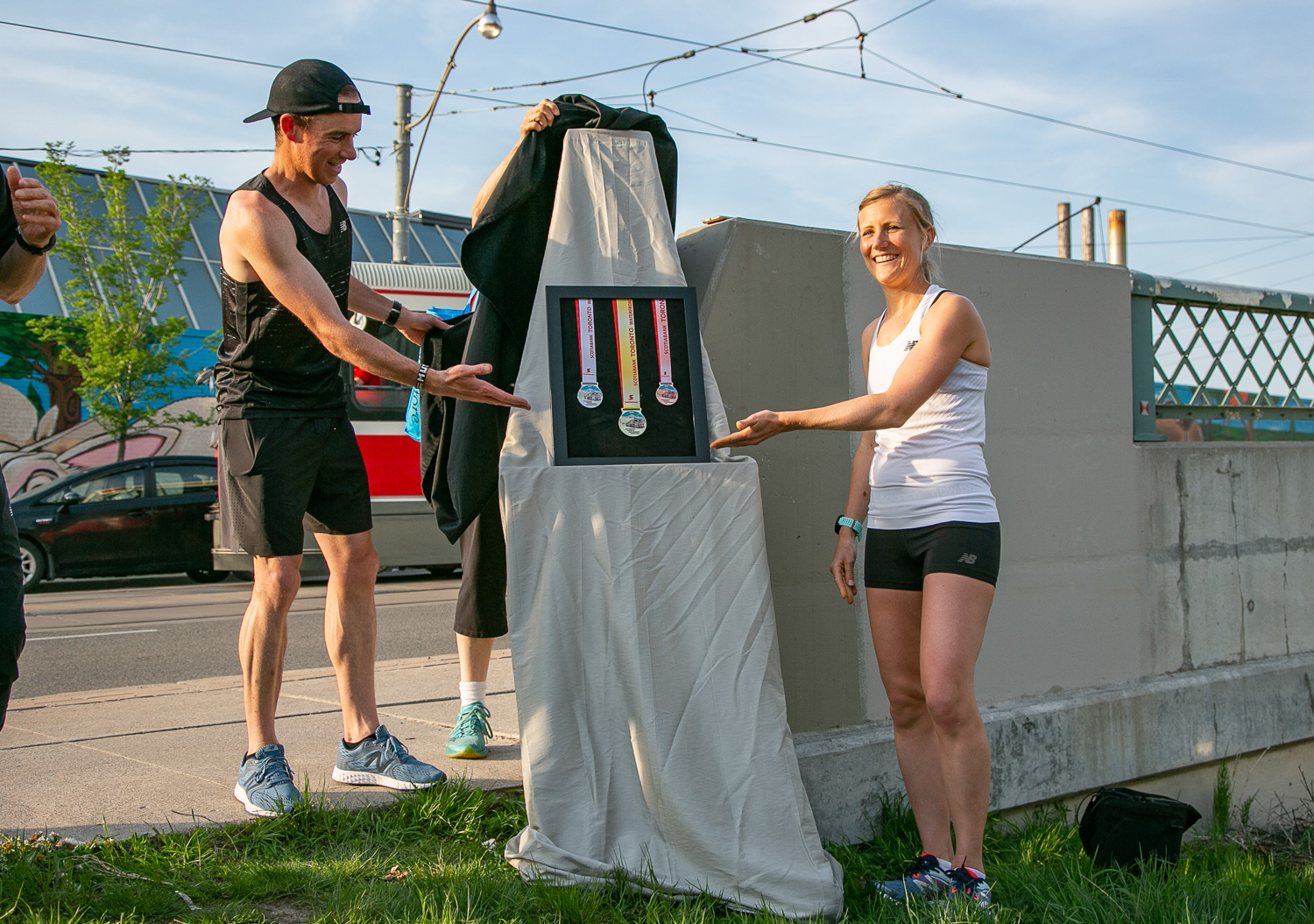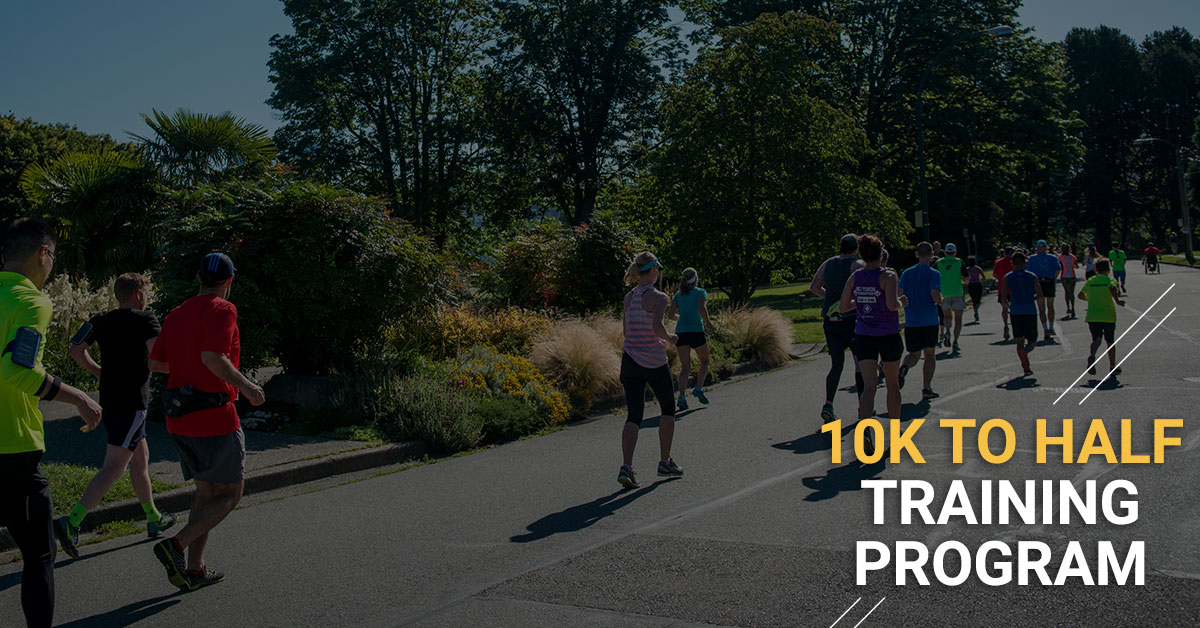
Two-time Olympian Reid Coolsaet shares the details of his vast medal and memorabilia collection, dating back to his high school running days, which includes hardware from Marathon Majors and the legendary Fukuoka Marathon

Two-time Olympian Reid Coolsaet shares the details of his vast medal and memorabilia collection, dating back to his high school running days, which includes hardware from Marathon Majors and the legendary Fukuoka Marathon

TTC-inspired race medals for Toronto’s largest marathon and just one of five IAAF Gold Label races in North America

Trying to get under the two-hour mark? Looking for a running buddy to keep you motivated through your race? Pacers are a great resource for runners to help maintain pace, keep you motivated, and maybe push you towards that elusive new PB!
We had an incredibly strong group of applications for our pacer positions this year, and we’re very excited to announce your 2018 Scotiabank Vancouver Half Marathon Pacers!
Pace Time: 2hr 30min
Name: Susan
A little about Susan:
“I started running with my first Learn-to-Run clinic in July 2012, and did my first half marathon in November 2013. Since then I’ve done 10 half marathons. I have attempted to do the Scotia Half a few times, but scheduling and injury derailed my plans. ”
“I paced my first half marathon last year and had a fantastic time, so I decided to do it again this year; and when Canada Running Series asked for pacing volunteers, I jumped at the chance. I am looking forward to bringing other racers across the finish line!”
 Pace Time: 2hr 30min
Pace Time: 2hr 30min
Name: Amanda
A little about Amanda:
“My name is Amanda and I was born and raised in Vancouver, BC. My passion for running started in high school and I’ve completed several races ranging from 10k to full marathons mainly in BC, but also in the US and Ireland. I’m excited to serve as a pacer for the 2018 Scotiabank Vancouver Half Marathon because I can’t wait to help you crush your goals! Whether your goal is to just finish the race or get a new personal best, I’ll be there with you every step of the way!”

Pace Time: 2hr 15min
Name: Meaghan
A little about Meaghan:
Meaghan started running in 2013 when her brother bet her on who could out run who at a 10K race (this is now an annual tradition!). Since then, Meaghan has run countless 10KM events, 11 half marathons and is currently training for her first full marathon. She is very excited to pace the 2:15 Scotiabank Half Marathon group and to help fellow runners crush their goals. When not out running with her husband James and their chocolate labrador Gus, you can find Meaghan at the local coffee shops or craft breweries.
 Pace Time: 2hr 15min
Pace Time: 2hr 15min
Name: Rose
A little about Rose:
“Hi there! My name is Rose and I am super excited to be a pacer for the Scotiabank Vancouver Half Marathon! I code most of my day away, so running is a welcome break for my brain and body. The Scotiabank Vancouver half marathon was my first half marathon and why I am so happy to be a pacer this year. Pacers have pushed me to PBs and finishes that I doubt I could have reached alone. I am very excited to help others reach their personal running goals.”
Pace Time: 2hr
Name: Paul
A little about Paul:
My name is Paul and I’m super excited to be the 2:00:00 pacer for the SVHM. I love setting HAGs (i.e. harry audacious goals) and working relentlessly to achieve them. In 2018, I’ll run the Boston, Berlin, and Chicago marathons. By achieving my HAGs, I aim to both role model and inspire my kids and others to set lofty goals and achieve them. As a SVHM pacer, I will encourage others by running alongside them and motivating them to achieve their own HAGs on what is one of the most stunningly beautiful courses.
 Pace Time: 2hr
Pace Time: 2hr
Name: Jaylene
A little about Jaylene:
“In the last five years I have developed a love and appreciation for running and created a lifestyle around it. With the help of mentors in the Running community that have challenged me and with my sense of determination I have completed my goal in running the Boston Marathon in 2017. ”
“Giving back to the running community has always been important to me. Helping fellow runners push themselves to meet new goals gives me a sense of accomplishment and pride as I give back to the community. ”
Pace Time: 1hr 45min
Name: Philip
A little about Philip:
“Hello! I am Phil Finlayson and I have the privilege of pacing the 1:45 group at the 2018 Scotiabank Half Marathon. This will be my fifth time running in this event. My favourite distances are 10K and Half Marathon, though I will have just finished my 3rdMarathon before we meet at the start line. You can find me sharing my love of running with the North Burnaby Runners, Phoenix Running Club, Sun Run Clinics and sometimes even with crews west of Boundary Rd.”
 Pace Time: 1hr 45min
Pace Time: 1hr 45min
Name: Dan
A little about Dan:
Originally from the UK, Dan ran his first 10k in London back in 2001. He didn’t get back into it until 2013 when he joined a local run group (at Rackets & Runners) to improve his distance and find a supportive run community. You can find Dan at road races of many distances; he’s lost count of how many, but the half is still his favourite. He’s also competed in 12 triathlons of all distances except the full Ironman; that’s his main focus for this year, as he’ll be competing at Ironman Canada in July. He’s looking forward to working to help others meet their goals at this year’s race!

Come for the run, stay for the fun!
Join Natasha Wodak, Sasha Gollish and our Canada Running Series community at Run Barbados Marathon Weekend, December 7th – 9th 2018. We’ll be at the races, on the beach, for a few easy runs, and out on the town! It’s the ultimate CRS year-end reward!
Congratulations to this year’s contest winner, LISA EDWARDS!
You’re invited to join Lisa and our Canada Running Series community in Barbados this year – just follow these 3 Easy Steps:
1. Go to runbarbados.org to register for you event(s).
2. Book your stay at one of the Official Hotels offering great rates.
3. Contact Marge at Marville Travel to get the best deals on airfare.

There’s a race for everyone: 1 Mile, 5K, 10K, Half-marathon, and Marathon, spread through Friday, Saturday and Sunday.
Race details: www.runbarbados.org

The Scotiabank Vancouver Half Marathon is proud to support local charities as part of the Scotiabank Charity Challenge, with the goal of raising over $1,000,000 annually for local charities. Each year, charities such as the Alzheimer Society of BC build fundraising teams to support their causes, with runners participating in both the half-marathon and the 5k races.
Here’s a look at some team members raising money for the Alzheimer Society of BC:
Participant Name: Bark Kong
Goal Time: Under two hours for the half-marathon
Running wisdom: “Take the first step and be patient with yourself… it’s more about the process than the finish. Don’t go out too hard. It’s not a sprint; it’s like running a marathon, well…except it’s half. There is a lot of training information available on the internet, so find a program that works for you and decide to do it!”
Why he runs: “It’s both the challenge of doing something hard and the satisfaction of knowing that you’ve done it.”
What’s special about the Scotiabank Vancouver Half-Marathon & 5k: “Not only is this event a way for me to use my love for running to raise funds, it lets me get to know my friends and colleagues in a new and fun way. For example, I learned that Emily (Pridham, Manager, Regional Services for Vancouver Island) is really competitive – almost as much as I am.”
Bark is the veteran runner on the team. With six full marathons and eight half-marathons under his hydration belt, he’s more than ready to take on the mental challenge of 21.1 kilometres alone with his thoughts – with the help of a healthy cheering section on race day. This is the third consecutive Scotiabank Vancouver Half-Marathon & 5k that he’ll tackle with the help of high-altitude, trail and road training and some intense metal in his headphones. Still smarting from a devastating loss last year to his worthy competitor, Emily Pridham, he has a new training program that is driven by the raw desire to come out ahead of his much younger colleagues. To show Bark your support, visit his fundraising page.
Participant Name: Emily Pridham
Goal Time: Under two hours for the half-marathon… and to beat Bark!
Message to other new runners: “Don’t be scared to try something uncomfortable. Ease in gently and set goals.”
What she learned about herself at her first Scotiabank Vancouver Half-Marathon & 5k in 2017: “I was surprised by how into the fundraising I got. I got competitive because I saw [my teammates’] totals going up and I didn’t want to be left in the dust!” (Emily started her fundraising with tentative social media posts and ended up enthusiastically knocking on her neighbours’ doors.)
Emily is an avid cyclist, but until last year, she had never run more than 10k. A month before the Scotiabank Vancouver Half-Marathon & 5k, she was inspired by Bark and Theresa Frazao – who was also planning to run her first half-marathon for the Society – and she joined the team. The combination of her love for physical and leadership challenges, the healthy competition with her colleagues and the opportunity to embody the philanthropic spirit of the Society was enough to drive Emily to the finish line with little preparation. At the end of her dramatic debut, Emily beat Bark to the finish line by a minute. Complicating her win, however, shortly after the race, Bark learned he had been running with appendicitis. Now he’s back to full strength and ready for his re-match. Emily, with a year of running behind her, isn’t about to hand the top spot over to Bark – or the latest contender to join the office road race. To show your support for Emily, visit her fundraising page.
Participant Name: Allison Baker (aka, The Mystery Runner)
Goal Time: 1:45 for the half-marathon
Where she runs: Along the beach in Tsawwassen.
Why join the Scotiabank Vancouver Half-Marathon & 5k? “To be a part of a team. Running can be a very lonely sport. I’m excited to do it with a team because I’m extra competitive and I’m usually just competing with myself.”
Message to her teammates: “Bring it on!”
Earlier this year, when the Society team began to take shape at the provincial office, Allison threw her hat in the ring for the half-marathon – without revealing her identity to her teammates. At first, The Mystery Runner in the office sparked intrigue. Now that the secret’s out, so is the truth about Allison’s running resume. She has completed two full marathons and is now training for her third. Allison initially took up running at the age of 14 to impress her hockey coach and later fell in love with the endorphins she found pounding the pavement to her pop favourites. Will the ‘90s nostalgia of the Spice Girls and ‘N Sync propel her to the finish line before her colleagues? That part’s still a mystery. To show your support for Allison, visit her fundraising page.
Participant Name: Theresa Frazao
Goal: “To run a strong 5k in June and use these beautiful spring months to get outside and run again.”
Why she runs: “I love the endorphins and doing what I can to be fit and strong. I also love how meditative it is. It’s really hard to think about your problems when you are running.”
Run tunes: Fast, energetic pop songs to keep up her pace.
Last year Theresa completed her first half-marathon on the Society team. This year, she’ll be returning to the 5k distance and joining thousands of other runners and walkers on the shorter course. To all the less-competitive runners out there, Theresa has this to say: “5k is the perfect distance to participate in an event like this because you can run, you can walk or you can do a combination of the two. And you can recruit some friends to come out for the morning and walk or run with you! The crowds, the entertainment, the cheerleaders and the charity village all add to a great festival environment and you’ll have a blast while doing some good for the Alzheimer Society of B.C.” To show Theresa your support, visit her fundraising page.

Just finished the Sun Run? Well that means you should be able to run a Half-Marathon! Follow along with this simple nine week program to get you ready for the Scotiabank Vancouver Half-Marathon in June. No more excuses — get out the door and get ready to run! Register for the run today!
| WEEK | MON | TUE | WED | THU | FRI | SAT | SUN |
| Apr 23–29 | Rest | 4km | Cross-train | 4km | Rest | Cross-train | 7km |
| Apr 30–May 6 | Rest | 5km | Cross-train | 4km | Rest | Cross-train | 10km |
| May 7–13 | Rest | 6km | Cross-train | 5km w/ hills | Rest | Cross-train | 12km |
| May 14–20 | Rest | 6km | Cross-train | 6km | Rest | Cross-train | 14km |
| May 21–27 | Rest | 7km | Cross-train | 6km w/ hills | Rest | Cross-train | 16km |
| May 28–June 3 | Rest | 8km | Cross-train | 7km | Rest | Cross-train | 18km |
| June 4–10 | Rest | 8km | Cross-train | 7km w/ hills | Rest | Cross-train | 20km |
| June 11–17 | Rest | 8km | Cross-train | 7km w/ hills | Rest | Cross-train | 12km |
| June 18–24 | Rest | 5km | Rest | 4km | Rest | Rest | 21.1km — Event Day |
Cross-train with swimming, hiking, cycling, yoga, or strength training. Make sure not to over do it on these days as they are part of your recovery process. When adding in hills, try to incorporate a few steady climbs into your route, anywhere from 200m to 500m long.

Par Laurent Godbout
Montréal (22 avril) – Profitant de conditions atmosphériques idéales au départ, les coureurs ontariens Tristan Woodfine, chez les hommes, et Sasha Gollish, chez les dames, ont remporté des victoires sans équivoque dimanche au Parc Jean-Drapeau de Montréal, pour la 16ème édition de la Banque Scotia 21k de Montréal.
Woodfine, 24 ans, de Cobden, Ontario, franchissait la ligne d’arrivée située aux abords du bassin d’aviron olympique en 1h05min43s. Gollish, 36 ans, de Toronto, remportait l’épreuve féminine en 1h16min14s.
Woodfine en contrôle
Dès le départ, Woodfine partait doucement avec le groupe de favoris parmi lesquels on retrouvait le champion en titre de 2017 François Jarry, l’Albertain Kip Kangogo, Baghdad Rachem, Jacques-Sylvain Lecointre et Adam Hortian, de Kitchener.
Le petit peloton de six coureurs s’est rapidement étiré et dès le 5ème kilomètre passé en 15:53, Woodfine menait, accompagné de Jarry et Kangogo. Accumulant des kilomètres à une moyenne de 3:06-3:07, les trois meneurs passaient les 10km en 31:30. Woodfine était visiblement le plus à l’aise, tandis que Jarry, à 30 secondes de son meilleur chrono sur route, grimaçait déjà.
Pendant ce temps, le peloton féminin, entouré de quelques coureurs masculins, était déjà réduit à trois athlètes, soit Anne-Marie Comeau, de St-Férréol-les-Neiges, et les Torontoises Sasha Gollish et Laura Desjardins. On avait vu au départ Leslie Sexton, une des favorites, mais la coureuse de London abandonnait dès le 2ème kilomètre.
Pendant que Gollish pratiquait quelque peu son français avec les «boys» qui l’entourait, Comeau, à sa première tentative sur la distance de 21,1 km, était à la tête du groupe qui franchissait les 10 kilomètres en 36 :38. À quelques mètres derrière, Desjardins ne semblait plus capable de tenir la cadence imposée par les meneuses. Très à l’aise, Gollish nous a semblé au beau milieu d’une longue séance d’entraînement!
Les choses se sont rapidement précipitées pour tout le monde entre le 10ème et le 14ème kilomètre. Pendant que Woodfine maintenait le rythme en enfilant des kilomètres en 3 :07, Jarry était décroché et accusait un retard de 28 secondes au 15ème tandis que Kip Kangogo suivait à 75 secondes du meneur. Au 4ème rang, Adam Hortiam pouvait bien voir Kip devant lui mais n’a jamais pu le rattraper.
On peut affirmer sans l’ombre d’un doute, avec ce chrono de 1h05m43s, que Woodfine en avait encore pas mal sous le pied et qu’il aurait certainement pu améliorer son record personnel (1h05m28s) s’il avait été poussé. Jarry, deuxième en 1h07m28s, conserva une avance importante sur Kangogo, 3ème en 1h08m15s.
«J’ai pris un bon départ, expliqua Woodfine à l’arrivée. Je me suis placé 3ème au début mais dès le 4ème kilomètre, je voulais voir qui pourrait me suivre. À partir de là, on avait déjà creusé un petit écart. Au 10km, je me sentais bien et j’ai poursuivi mon effort. J’étais un peu surpris de voir que Kip (Kangogo) n’était plus là. C’est un bon coureur et il a eu un hiver très difficile en Alberta. Je suis certain qu’il reviendra plus fort bientôt.»
Jarry était relativement satisfait de sa course. «Woodfine a fait une bonne course et il était plus fort aujourd’hui. Comme j’ai été malade autour de Pâques, je ne savais pas trop comment ça allait se passer. Considérant tout ce qui n’allait pas bien, c’est quand même un PB et je n’aurais pas pu demander plus.»
Jarry a bien tenté de demeurer près de Woodfine, mais ce dernier a lancé une attaque qui a fait mal à partir du 12ème kilomètre. «Autour de 12-13km, on s’en allait dans un vent de face et c’est là que ça faisait le plus mal, dit encore Jarry. À ce moment-là, je ne pouvais pas répondre et j’ai commencé à cramper. J’ai essayé de revenir sur lui vers le 15ème mais il était trop tard.»
Un résultat de bon augure pour Jarry, qui prévoit courir son premier marathon à Toronto l’automne prochain. Pour Woodfine, il s’agissait d’une dernière course avant le marathon d’Ottawa. «Ce résultat est une bonne indication qu’on est sur la bonne voie. J’ai bien aimé le parcours. Il y avait quelques virages où je me suis efforcé d’accélérer pour prendre un avantage. Je veux juste poursuivre mon entraînement pour Ottawa avec encore quelques semaines solides et ensuite diminuer à l’approche de la course.»
Gollish s’amuse
Gollish s’est montrée plus patiente et donna le coup de grâce en fin de course, terminant sous les applaudissements nourris en 1h16m14s, devançant Comeau par 11 secondes. Desjardins réussit à conserver la 3ème place pour terminer en 1h17m59s.
Coureuse parmi les plus polyvalentes au Canada, elle était de très bonne humeur à l’arrivée. «Je me sentais fatiguée en arrivant ici après un gros entraînement avant-hier. Je ne me suis pas entraîné hier et je voulais juste avoir du plaisir. Je suis demeuré dans le sillon du groupe et j’ai essayé de m’amuser tout au long de la course.»
Ce besoin de détente était bien évident avant le départ puisque Gollish parlait avec tous les coureurs à la ligne de départ. «Il ne faut pas sous-estimer l’importance du relâchement dans une course. Si on peut rendre l’effort moins pénible en relaxant, je crois que ça peut conduire à un meilleur résultat. J’aime bien avoir du plaisir en course.»
Loin d’être à la recherche d’un gros chrono, Gollish a abordé l’épreuve comme un long tempo. «Mon français est terrible, je comprends un peu mais je me suis pratiqué un peu. J’ai essayé de faire ma petite affaire.»
Gollish a maintenant des ambitions sur la distance du marathon. «Je vais quand même tenter de courir un 5000 mètres sur piste en mai. Le plan sera ensuite vers un marathon à l’automne, probablement à Berlin.»
Sans exception, tous les coureurs ont apprécié le parcours. Gollish a bien résumé le sentiment des athlètes. «Loin des voitures, dans ce grand parc, on était vraiment bien.»
Woodfine and Gollish Big Winners in Montreal
By Laurent Godbout
Montreal (April 22) – Taking advantage of ideal weather conditions at the start, Ontario runners Tristan Woodfine and Sasha Gollish won unequivocal victories on Sunday at Parc Jean-Drapeau in Montréal for the 16th edition of the Banque Scotia 21k de Montréal.
Woodfine, 24, of Cobden, Ont., crossed the finish line at the edge of the Olympic rowing basin in 1h05m43s. Gollish, 36, of Toronto, won the women’s event in 1h16min14s.
Woodfine in control
From the start, Woodfine was with a small group of favorites, including defending champion François Jarry from Montréal, Alberta’s Kip Kangogo, Baghdad Rachem, Jacques-Sylvain Lecointre and Adam Hortian of Kitchener. The small pack of six runners quickly spread out and passed 5 kilometres in 15:53, where Woodfine took the lead, followed by Jarry and Kangogo. Maintaining an average pace of 3:06-3:07/km, the three leaders passed 10km in 31:30. Woodfine was obviously the most comfortable, while Jarry, 30 seconds off his best time on the road, was already wincing.
Meanwhile, the women’s lead group, surrounded by a few male runners, was already reduced to three athletes, namely Anne-Marie Comeau, of St-Férréol-les-Neiges, and Toronto’s Sasha Gollish and Laura Desjardins. Leslie Sexton, one of the favorites, was seen at the start, but the London runner gave up near the second kilometer.
While Gollish was practicing her French conversation with the “boys” around her, Comeau, at her first attempt at the 21.1 km distance, was leading the group, passing 10 kilometers in 36:38. A few meters behind, Desjardins no longer seemed able to maintain pace with the leaders. Looking very comfortable, Gollish seemed to be in the middle of a long workout!
Things changed quickly for everyone between kilometers 10 and 14. While Woodfine kept a 3:07/km pace, Jarry was slowly letting go and was 28 seconds behind at 15km, while Kip Kangogo fell to 75 seconds behind the leader. In 4th place, Adam Hortian could see Kip in front of him but was unable to catch him.
Beyond a shadow of a doubt, with his winning time of 1:05:43, Woodfine still had a lot left in his legs and could certainly have improved his personal best (1:05:28s) if he had been pushed. Jarry, second in 1:07:28, kept a significant lead over Kangogo, 3rd in 1:08:15.
“I had a good start,” Woodfine said less than a minute after he finished. I positioned myself in 3rd place at the beginning but from the 4th kilometre on I wanted to see who could follow me. From there, we had already dug a small gap. At 10km, I felt good and I continued my effort. I was a little surprised to see that Kip was no longer there. He is a good runner and has had a very tough winter in Alberta. I’m sure he’ll come back to his best soon. ”
Jarry was relatively happy with his race. “Woodfine had a good race and he was stronger today. As I was sick around Easter, I did not really know how it was going to be. Considering all that went wrong, this is still a PB for me and I could not have asked for more.”
Jarry tried to stay in close range of the leader, but Woodfine launched an attack that hurt from the 12th kilometer. “Around 12-13km, we went in a headwind and that’s where it hurt,” said Jarry again. At that moment, I could not respond and started to cramp. I tried to get back to him around 15km but it was too late.” Overall, it was a positive result for Jarry who plans to run his first marathon in Toronto next fall.
For Woodfine, this was his last race before the Ottawa Marathon. “This result is a good indication that we are on the right track. I enjoyed the course. There were a few bends where I went hard to accelerate and take advantage. I just want to continue my training for Ottawa with a few solid weeks and then decrease as the race approaches.”
Gollish relaxed and having fun
Sasha Gollish crossed the finish line looking relaxed and patient, throwing a final knockout punch near the end of the race. Finishing to loud cheers from the crowd in 1:16:14, she edged Anne-Marie Comeau by 11 seconds. Laura Desjardins managed to stay in 3rd place to finish in 1:17:59.
This was an impressive result from Comeau on her first attempt at the distance. The 21 year old Olympic cross-country skier ran without much knowledge of her abilities for the half marathon and was quite satisfied with the result.
One of the most versatile runners in Canada, Sasha Gollish was in a very good mood upon arrival. “I felt tired coming here after a massive training the day before yesterday. I did not train yesterday and I just wanted to have fun. I stayed in the groove of the group and tried to have fun all along the race. ”
This sense of calm was obvious before the start as Gollish spoke with all the runners at the starting line. “We must not underestimate the importance of relaxation in a race. If we can make the effort less painful by relaxing, I think it can lead to a better result. I like having fun in the race. ”
Far from looking for a fast time, Gollish approached the race like a long tempo run. “My French is terrible, I understand a bit, but I practiced a little. I tried to stay focused on my business. ”
Gollish now has ambitions for the marathon. “I will still try to run a 5000 meter track in May. The plan will then be geared towards a marathon in the fall, probably in Berlin. ”
Without exception, all the elite runners appreciated the course. Gollish pretty much summed up the feelings of the group. “Far from cars, in this big park, it felt really good.”
For full race results, visit: https://bit.ly/2pPsK0n

Par Paul Gains
Malgré un grand nombre de modifications au parcours par la construction au Parc Jean-Drapeau, le Banque Scotia 21k de Montréal attire encore cette année un peloton de bons coureurs ayant des visées sur les nombreuses bourses, des points importants pour le Circuit de course du Canada et un bon défi de début de saison.
L’épreuve montréalaise est la deuxième de huit courses du Circuit de course du Canada en 2018.
Les deux champions en titre du Circuit, Tristan Woodfine et Leslie Sexton, seront parmi les favoris, les deux athlètes ayant bien amorcé la saison 2018 avec des victoires au 8km Race Roster Spring Run-Off le 7 avril dernier.
Du côté masculin, l’international canadien Kip Kangogo traversera le pays pour livrer la lutte à Woodfine ainsi qu’au champion de l’édition 2017 de Montréal, François Jarry.
Le sympathique Jarry, étudiant à l’université McGill, n’aura qu’à prendre le métro pour se rendre à la ligne de départ. En dépit de l’admiration et du respect qu’il porte à ses rivaux, François n’a pas l’intention d’être trop généreux envers les visiteurs. N’ayant rien à perdre, il se trouve dans une position de négligé face aux favoris Woodfine et Kangogo. Et c’est ce qui peut parfois faire ressortir le meilleur d’un athlète.
Dans l’épreuve féminine, Sexton sera talonnée par celle qui l’a suivie au deuxième rang à Toronto. Laura Desjardins, une chiropodiâtre, prend son pied, c’est le moins qu’on puisse dire, dans les épreuves de longue distance. Une autre concurrente à surveiller, inscrite au dernier moment, sera Sasha Gollish. Contrainte à l’abandon lors du 8km de Toronto, la médaillée du 1500 mètres des Jeux panaméricains a déjà fait ses preuves sur les distances plus longues et sera dure à battre si elle est en possession de tous ses moyens.
Les Élites à surveiller:
Tristan Woodfine, 24 ans, indépendant, Cobden, Ontario
Le champion en titre du Circuit de course du Canada, Woodfine préconise présentement un volume plus élevé d’entraînement dans sa préparation pour le Marathon Scotiabank d’Ottawa le 27 mai prochain. Dans une semaine d’entraînement plus légère, ce fut une belle surprise pour lui de remporter le 8km Race Roster Spring Run Off à Toronto. Woodfine détient un record personnel de 1h05.28 au demi-marathon.
Woodfine n’aspire pas à un chrono rapide sur le parcours montréalais, surtout depuis l’ajout de plusieurs virages. Étudiant au Collège de Santé et Technologie de l’Ontario, il souhaite devenir ambulancier paramédical.
“Ce sera beaucoup plus pour déployer un gros effort à cinq semaines du marathon d’Ottawa”, explique-t-il. “Je ne suis pas certain qui sera de la course mais s’il y a une bonne compétition cela ajoute au plaisir de courir. L’objectif numéro un est de donner un gros effort en préparation pour Ottawa et s’il y a des coureurs rapides c’est un boni. ”
“J’ai affronté Kip (Kangogo) quelques fois. Il est présent sur la scène canadienne depuis plusieurs années et il est toujours un athlète compétitif. Je ne sais pas si j’ai déjà couru contre François (Jarry), mais n’importe qui peut connaître une bonne course un jour donné et il faut sortir avec l’idée de faire de son mieux et voir où cela va vous mener.”
Leslie Sexton, 30 ans, London Runner, London, Ontario
En octobre 2017, Sexton était couronnée Championne canadienne du marathon malgré une blessure qui avait retardé son début de saison. Présentement en pleine forme, comme elle l’a démontré lors de sa première victoire de l’année à Toronto, elle est maintenant prête au test du demi-marathon. Améliorer son record personnel de 1h13.13 n’est peut-être pas dans les cartes, en raison des nombreux changements sur le parcours du Parc Jean-Drapeau.
Sexton est plutôt motivée par la possibilité d’ajouter des points au classement du Circuit de courses du Canada à Montréal. Encore plus, elle insiste sur l’importance de voir si son volume d’entraînement élevé sera bénéfique. Cette course fait donc partie d’un plan plus général.
“Je dirais que même sans les points du circuit, je participerais à plusieurs courses du circuit de toute façon,” avoue Sexton. “Il s’agit d’une belle occasion de remporter une bourse en argent et me faire connaître un peu plus. Cette année, j’ai l’intention de participer à cinq ou six courses et peut-être demeurer dans la lutte pour le classement général du circuit encore cette année.
“Le plan pour ce printemps n’est pas de courir un marathon mais de travailler à mon demi-marathon et mon 10 km. La date de Montréal au calendrier était bonne pour un objectif au demi-marathon me donnera trois semaines avant les championnats de 10 000 mètres sur piste de l’Ontario. Je n’ai pas couru sur le parcours de Montréal depuis 2012 (elle était 2ème) et c’était alors un Championnat canadien. Même avec la construction autour, je pense pouvoir obtenir un temps rapide.”
Kip Kangogo, 38 ans, Lethbridge, Alberta
Toujours un fort compétiteur sur les routes, le Canadien d’origine kényane est le plus rapide sur papier avec un record personnel de 1h03.22, réalisé au Scotiabank Vancouver Half Marathon de 2011. Le printemps dernier, Kip avait aussi remporté le titre de champion canadien au Demi-marathon de Calgary. En 2016, il avait remporté la victoire au 21k Scotia de Montréal.
Ces jours-ci, il travaille six heures par jour pour la commission des écoles du District de Lethbridge, ce qui lui permet du temps avec son épouse et ses deux jeunes enfants en plus de pouvoir s’entraîner. Ayant changé d’entraîneur, il exécute les entraînements preparés par le coach kényan Matthew Cheriuyot. Il est aussi un athlète de l’équipe Skechers Performance du Canada.
“Je veux un bon test pour débuter ma saison et Montréal est un bon endroit pour le faire,” dit-il. “J’y suis déjà allé en 2016 et c’est un bon endroit. Ç’a été un hiver difficile mais j’ai bien hâte de voir où en est ma forme en ce début de saison. ”
Sasha Gollish, 36 ans, University of Toronto TC, Toronto, Ontario
Arrivée tardivement à la course de fond, la candidate au doctorat en Génie excelle des épreuves du 1500 mètres au demi-marathon.
En 2015, elle remportait la médaille de bronze du 1500 mètres des Jeux panaméricains. Elle a aussi à sa fiche un record personnel de 1h11.05 au demi-marathon, ce qui la situe au 3ème rang de tous les temps au Canada. Plus récemment, elle a été la meilleure Canadienne des championnats du monde IAAF de demi-marathon à Valence, terminant 30ème en 1h11.52. Malade, elle devait abandonner lors du 8km Race Roster Spring Run Off mais elle est maintenant prête à rejoindre l’élite du peloton de Montréal.
Francois Jarry, 24 ans, Athlétisme Ville-Marie, Montréal, Quebec
Il y a un an, cet étudiant de l’université McGill émergeait comme l’un des bons jeunes coureurs du Québec en remportant 21k Banque Scotia de Montréal en 1h07.23 en terminant par la suite au 4ème rang des championnats canadiens de Demi-marathon à Calgary. Remporter la course de Montréal devant ses amis et supporteurs fut, dit-il, ‘’une de mes plus belles réalisations.’’
Suite à cette victoire, François a été récompensé en étant nommé parmi les athlètes Skechers Performance du Canada comme son rival Kip Kangogo. À l’évidence, il voue un énorme respect au champion canadien.
“Oh, est-ce qu’il sera là ? Je le connais. Je n’avais pas encore vu la liste de départ. Et bien s’il est là, ce ne sera pas facile,” dit Jarry en riant. “Je l’ai vu à Calgary l’année dernière et je sais qu’il est pas mal rapide. S’il est dans la forme habituelle, j’aurai besoin d’un gros ‘pb’ pour avoir une chance contre lui.
“J’avais un bon volume d’entraînement récemment mais cela vous rend plus vulnérable à la maladie. J’ai été malade durant la période de Pâques j’ai dû prendre une pause de près d’une semaine. J’espère que je pourrai garder la forme, ça pourrait être un grande course.”
Anne-Marie Comeau, 21 ans, Université Laval, Québec
En grandissant à Mont Ste-Anne, Comeau a été amenée au ski de fond en bas âge et a participé à de nombreuses compétitions internationales au cours de son adolescence. Mais lorsqu’elle est entrée à l’université Laval en sciences comptables en 2015, elle passa beaucoup plus de temps à la course en cross-country et représentait l’équipe universitaire du Rouge & Or.
Malgré cette absence fréquente des activités de son premier sport au cours des deux dernières années, Anne-Marie a tenté ultimement et avec succès un dernier coup pour se qualifier pour les Jeux olympiques d’hiver de 2018.
“J’ai couru en cross-country durant tout l’automne,” dit-elle. “Je courais beaucoup mais je ne m’entraînais pas tant que ça pour le ski et je me suis étonnée. J’étais en bonne forme et prête pour les Jeux olympiques.
“Le ski de fond est très bon pour la course mais la course est aussi bonne pour le ski. Quand je fais les deux, je me sens bien pour les deux. En ski, j’ai moins de blessures qu’à la course. Les blessures les plus sérieuses en ski sont les tendinites aux épaules. J’en ai eu une il y a deux ans, parce que la double poussée est très dure pour les épaules. Par contre, on n’a pas de blessures aux pieds ou aux genoux.
“Ce sera ma première expérience au demi-marathon. Comme c’est ma première, je ne sais pas trop comment voir cette course, à quelle vitesse je démarrerai. Je ne veux pas partir trop vite parce que je ne sais pas ce que je peux maintenir sur 21 km. J’aimerais bien courir sous 1h20 ou 1h19 mais je ne sais honnêtement pas ce que je peux faire. ”
Laura Desjardins, 29 ans, Newmarket Huskies, Toronto, Ontario
Desjardins en a étonné plusieurs en terminant au 2ème rang lors du 8 km Race Roster Spring Run Off, un résultat qui l’a mis en confiance avant le 21k Banque Scotia de Montréal. En octobre dernier, elle a fait ses débuts au demi-marathon à Toronto en 1h17.24.
“Je sens que j’ai appris quelque chose lors du 8km de Toronto. Préparation, affûtage, nutrition, repos, éléments de récupération,” dit-elle. “J’ai appris de ça et je pense que ça va m’aider pour le demi de Montréal.
Sous la direction du réputé entraîneur de fond Hugh Cameron, elle a augmenté son entraînement de manière significative cet hiver en vue de la saison de compétitions. Programme d’entraînement réalisé tout en poursuivant son travail chez Premier Footworks à Mississauga.
“Je suis relativement nouvelle sur l’entraînement de fond et c’est ma première année avec un plus gros volume et plus de kilométrage, en plus de mes heures de travail par semaine,” explique-t-elle. “Ça m’a demandé une adaptation.”
“Je m’habitue à ce volume et cette intensité à l’entraînement et je veux voir où j’en suis. C’est une sorte d’année d’expérimentation avec différentes distances et voir comment mon corps s’adapte à ces courses. Il n’y a pas de courses de qualification pour des épreuves mondiales. Le demi-marathon Scotiabank de Toronto et le championnat canadien de 10 km à Ottawa seront les plus importantes.”

By Paul Gains
Despite several course changes due to ongoing construction inside Parc Jean Drapeau the Banque Scotia 21k de Montréal has attracted a strong field intent on chasing prize money, Canada Running Series points and an early season challenge.
The event is the second stop on the eight race 2018 CRS circuit.
Leading the elite field are the two defending CRS champions, Tristan Woodfine and Leslie Sexton, who launched their 2018 CRS campaigns in victorious fashion at Toronto’s Race Roster Spring Run Off 8k, April 7th.
Canadian international Kip Kangogo, flies across the country to do battle with Woodfine and defending Montréal champion, Francois Jarry.
The personable Jarry, a McGill University student, will hop the Metro to get to the race but although he admires and respects his rivals he doesn’t intend to be the perfect host. With nothing to lose he is in a comfortable position compared to the favoured Woodfine and Kangogo. And that can often bring out the best in a competitor.
Meanwhile, Sexton will be shadowed by the woman who finished second to her in Toronto, Laura Desjardins, a practicing chiropodist, who is finding her feet in the longer distances. A late addition to the field is Sasha Gollish who, under duress, dropped out of the RRSRO 8k. The Pan Am Games 1,500m gold medalist is an accomplished distance runner and if fully fit will prove difficult to beat.
Elites to Watch:
Tristan Woodfine 24, Unattached, Cobden, Ontario
The defending CRS overall champion Woodfine is embracing a higher training volume as he prepares for the Scotiabank Ottawa Marathon May 27. Dropping down and winning the Race Roster Spring Run Off 8km in Toronto was a pleasant surprise in light of the training. Even so he has a best half marathon time of 1:05:28.
Running fast over the Montréal course particularly with the addition of a few more turns is no longer the target for Woodfine who is now studying at the Ontario Health and Technology College. He intends to become a paramedic.
“It’s more about getting a good hard effort in five weeks before Ottawa,” he explains. “I am not sure who is going to be racing but if there is good competition there then that adds to the fun. Goal number one is get a good hard effort in preparation for Ottawa and if there are some fast guys to race that’s an added bonus.
“I have raced Kip a couple of times. He’s been on the Canadian running scene for many years and he is always a good competitor. I don’t know if I have ever raced Francois but anyone can have a good race on any given day so you just go out there and give it your best and see where you stack up.”
Leslie Sexton 30, London Runner, London, Ontario
Last October Sexton was crowned Canadian Marathon Champion despite an injury induced delay to the start of her 2017 season. Now, fully healthy and fit, as her recent victory in Toronto proved, she is ready to test herself over the 21k distance. Beating her personal best (1:13:13) is likely not in the cards this weekend due to the course changes.
The attraction of adding CRS points is one reason she is racing Montréal. More importantly she says is the importance of seeing how her high volume training has paid off. The race is part of a bigger picture.
“I would say even without the CRS points I would be doing a lot of CRS races anyway,” Sexton admits. “It’s just a great competitive opportunity to win prize money and get my name out there a bit more. This year I intend to do five or six races in the Series and hopefully contend for the Series win again.
“The plan for this spring was not to do a marathon but to work on my half marathon and my 10k. So the date of Montréal worked well to be a ‘goal’ half marathon and will give me about three weeks before I do the Ontario 10,000m championships. I haven’t run the Montréal course since 2012 (she was 2nd) when it was the Canadian Championships. Even with the construction, hopefully, I can still run a pretty fast time.”
Kip Kangogo 38, Lethbridge, Alberta
Always a strong competitor on the roads this Kenyan born Canadian citizen is the fastest on paper with a personal best of 1:03:22 from the 2011 Scotiabank Vancouver Half Marathon. Last spring he also won the Canadian Half Marathon championship in Calgary. More significantly he raced in Montreal in 2016 and won.
These days he is working six hours a day for the Lethbridge School District which he says allow him time with his wife and two young children as well as the opportunity to complete his training program. Having switched coaches he follows workouts prescribed by Kenyan Matthew Cheriuyot. He is also a Skechers Performance Canada Athlete.
“I am looking for a test to open my season and Montréal is a good place to do it,” he declares. “I have been there before (in 2016) and it’s a good environment. It has been a tough winter but I look forward to seeing where my fitness is as I start the season.”
Sasha Gollish 36, University of Toronto TC, Toronto, Ontario
A relative late comer to distance running this PhD Engineering candidate has excelled at distances from 1,500m up to the half marathon.
In 2015 she claimed the Pan Am Games 1,500m bronze. She also has a best half marathon time of 1:11:05 making her the third fastest Canadian of all time. Most recently she was Canada’s top finisher at the IAAF World Half Marathon Championships finishing 30th in 1:11:52. Illness forced her to drop out of the recent Race Roster Spring Run Off but she has rebounded to join the elite field for Montréal.
Francois Jarry 24, Athlétisme Ville-Marie, Montréal, Quebec
A year ago this McGill University student emerged as one of Quebec’s finest young runners winning the Banque Scotia 21k de Montreal in 1:07:23 and then finishing 4th at the Canadian Half Marathon Championships in Calgary. Winning this race in front of his hometown supporters was, he says, one of his greatest achievements.
Now he has been rewarded by being named a Skechers Performance Canada Athlete like his rival Kip Kangogo. Clearly he respects the Canadian champion immensely.
“Oh he is going to be there? I know him. I hadn’t seen the start list yet. If he is going to be there it is not going to be easy,” he says laughing. “I saw him in Calgary last year and I know he is pretty fast. If he is in the shape he usually is then I am going to need a very big ‘pb’ to have a chance against him.
“I was doing great training big volume but that makes you more susceptible to illness. I had some sickness over Easter and took me out for about a week. Hopefully most of my fitness will stay with me. It could be a great race.”
Anne-Marie Comeau 21, Laval University, Montréal, Quebec
Growing up in Mont Ste Anne, Quebec Comeau was introduced to cross country skiing at an early age and competed internationally as a youth. But when she enrolled in accounting at Laval University in 2015 she switched to cross country running and competed for the varsity team.
Despite this absence from her chosen sport she made a last ditch effort to qualify for Canada’s team to the 2018 Winter Olympics and was successful.
“I was doing cross country running all during the fall,” she says. “I was running a lot but wasn’t training so much for skiing so I surprised myself. I was in good shape and I was fine for the Olympics.
“Skiing is very good for running but also running is very good for skiing. When I do both I feel better for both. We get way less injuries than in running; the biggest injuries we have in skiing is tendonitis in the shoulders. I had one two years ago because the double pulling is really hard on the shoulders. But we don’t have injuries on our feet and knees.
“This is my first experience in the half marathon. Because it is my first one I don’t know how to see the race, which pace to start. I think I don’t want to start too fast because I don’t know the speed I can go for 21k. I would like to do under 1:20 or 1:19 but I don’t honestly know what I can do.”
Laura Desjardins 29, Newmarket Huskies, Toronto, Ontario
Desjardins surprised many with her second place finish at the Race Roster Spring Run Off 8km a race that has given her much more confidence going into the Banque Scotia 21k de Montréal. Last October she made her debut at the half marathon distance in Toronto finishing in 1:17:24.
“I feel like I have learned something from that (RRSRO 8k) race, preparing, tapering, nutrition, rest, recovery items,” she says. “I have learned from that and I think it will help me going into the ‘Montreal Half.’
Under the direction of noted distance coach, Hugh Cameron, she has increased her training significantly this winter in preparation for the racing season. This she has done around her employment as a Chiropodist at Premier Footworks in Mississauga.
“I am relatively new to the distance training this is my first year doing higher mileage higher volume on top of doing 40 hours of work and commuting,” she explains. “It was kind of an adjustment.”
“I am getting used to this volume and intensity in training and trying to see where I stand. It’s kind of a year of experimenting with different distances and seeing how the body adapts to those races. I know there is no major world qualifier. The Scotiabank Toronto Half Marathon is a big one, the 10k championships in Ottawa.”

Running lifts people up in many different ways and we want to know how it lifts you up. Here at Canada Running Series, running helps lift us up in so many ways, including knowing the impact we – as a running community – can have on cities we race in. In September, thousands of runners will join the Under Armour Eastside 10K to run in, for, and with the Eastside. We are lifted up by knowing we’ve been able to support an area of Vancouver that often doesn’t get the attention it deserves. In addition to bringing the Eastside community together, we have been able to raise $17,000 to support three fantastic charities: Downtown Eastside Women’s Centre, Greater Vancouver Foodbank and PHS Community Services Society.
The title partner for the Eastside 10K, Under Armour, has recently launched UA HOVR, the brand’s latest innovation in footwear cushioning technology. Dave Dombrow, Under Armour’s Chief Design Officer says that when designing UA HOVR, the company set out to create the perfect combination of cushioning plus responsiveness and energy return – to essentially lift you up. The new cushioning system was created to provide not only a cushioned ride but also energy return. “The development of UA HOVR was inspired by the insight that every step a runner takes has the impact of 2-4x their body weight, holding them down,” said Dombrow. If you’re in the market for a new pair of running shoes this spring, UA HOVR may be something you want to try.
Registration is now open for the Under Armour Eastside 10K. Sign up now! #UAEastside10K
